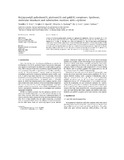Please use this identifier to cite or link to this item:
http://hdl.handle.net/10311/1032| Title: | Bis(pyrazolyl) palladium(II), platinum(II) and gold(III) complexes: Syntheses, molecular structures and substitution reactions with L-cysteine |
| Authors: | Keter, F.K. Ojwach, S.O. Oyetunji, O.A. Guzei, I.A. Darkwa, J. |
| Keywords: | Bis(pyrazolyl)acetic acid compounds Cytotoxicity Pseudo first-order Substitution L-cysteine |
| Issue Date: | 2009 |
| Publisher: | Elsevier Science Ltd, www.elsevier.com/locate/ica |
| Citation: | Keter, F.K. et al. (2009) Bis(pyrazolyl) palladium(II), platinum(II) and gold(III) complexes: Syntheses, molecular structures and substitution reactions with L-cysteine, Inorganica Chimica Acta, Vol. 362, No. 8, pp. 2595–2602 |
| Abstract: | A series of pyrazolyl palladium(II), platinum(II) and gold(III) complexes, [PdCl2(3,5-R2bpza)] {R = H (1), R = Me (2), bpza = bis-pyrazolyl acetic acid}, [PtCl2(3,5-R2bpza)] {R = H (3a), R = Me (4)}, [AuCl2(3,5- R2bpza)]Cl {R = H (5a), R = Me (6a)} and [PdCl2(3,5-R2bpzate)] {R = Me (7)} have been synthesised and structurally characterised. Single crystal X-ray crystallography showed that the pyrazolyl ligands exhibit N^N-coordination with the metals. Anticancer activities of six complexes 1–6a were investigated against CHO cells and were found to have low activities. Substitution reactions of selected complexes 1, 2, 3a and 5a with L-cysteine show that the low anticancer activities compounds and that the rate of substitution with sulfur-containing compounds is not the cause of the low anticancer activities. |
| URI: | http://hdl.handle.net/10311/1032 |
| ISSN: | 0020-1693 |
| Appears in Collections: | Research articles (Dept of Chemistry) |
Files in This Item:
| File | Description | Size | Format | |
|---|---|---|---|---|
| Keter_ICA_2009.pdf | 1.21 MB | Adobe PDF |  View/Open |
Items in DSpace are protected by copyright, with all rights reserved, unless otherwise indicated.
